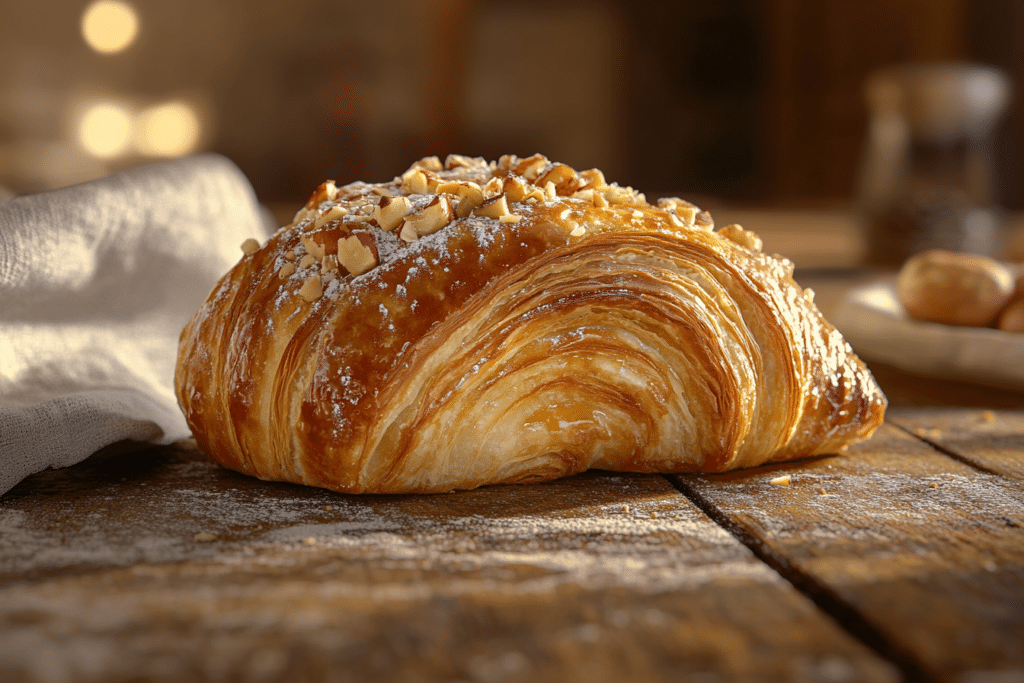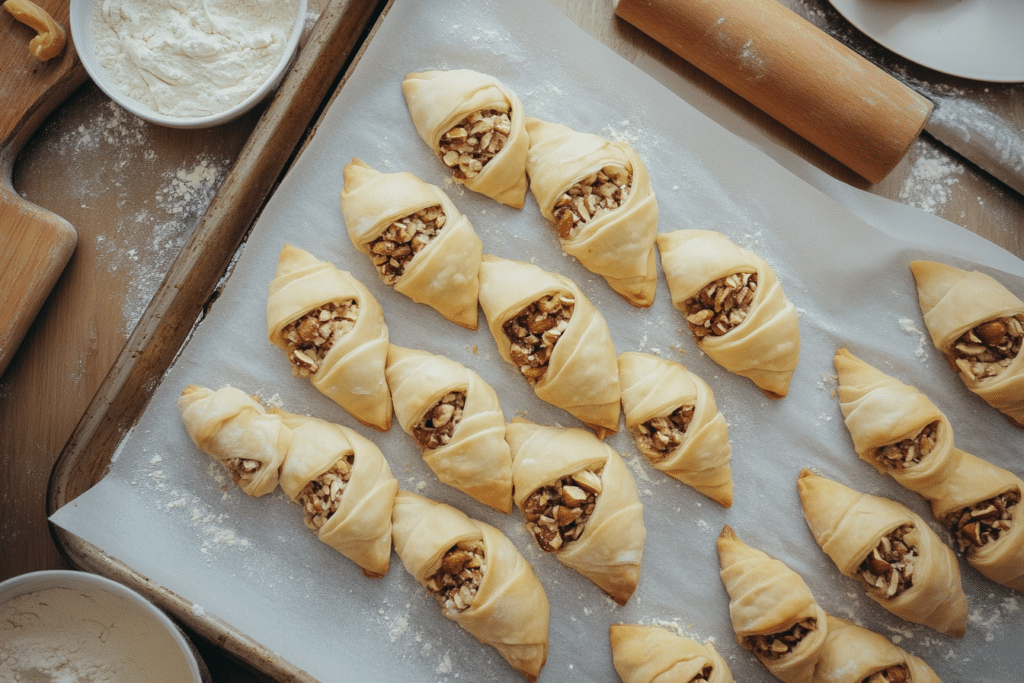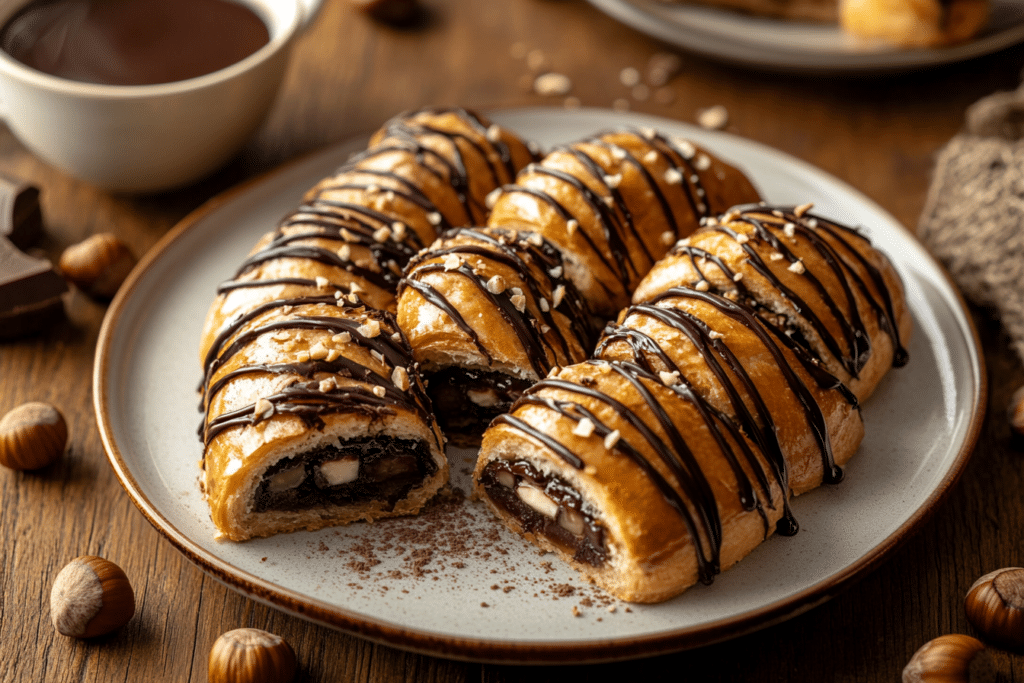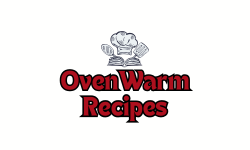1. Introduction
In the world of European pastries, Nussgipfel holds a special place as a beloved Swiss treat. Known for its distinct crescent shape and nutty, sweet filling, Nussgipfel combines the buttery flakiness of pastry with a flavorful, rich nut mixture. Found in bakeries across Switzerland, this staple is enjoyed during breakfast, as a mid-day snack, or as a reward after a long hike in the Alps.
So, what is a Nussgipfel? Simply put, it’s a nut-filled croissant-like pastry that delivers both texture and taste in every bite. Its deep roots in Swiss culinary traditions make it more than just a baked good; it’s a cultural delight that reflects the artistry of European baking.
In this article, we’ll dive into the details of what a Nussgipfel is, exploring its origins, ingredients, and how you can prepare one at home. We’ll also cover variations, tips for achieving the perfect Nussgipfel, and answers to frequently asked questions. By the end of this guide, you’ll not only understand what makes a Nussgipfel unique but also feel inspired to try it for yourself.
2. What is a Nussgipfel?
2.1 Defining Nussgipfel

A Nussgipfel is a traditional Swiss pastry known for its delicate crescent shape and sweet, nutty filling. The word “Nussgipfel” translates to “nut peak” in German, perfectly describing the pastry’s appearance and flavor. At its core, a Nussgipfel combines:
- A flaky exterior: Made from either puff pastry or yeast dough, which gives it a crisp and buttery texture.
- A nut-based filling: Typically a rich mixture of finely ground hazelnuts, almonds, sugar, and subtle hints of spices like cinnamon or vanilla.
Often described as a nutty cousin of the croissant, the Nussgipfel is slightly denser and richer due to its filling. The combination of the flaky crust and creamy, aromatic nut mixture makes it a standout in Swiss bakeries.
2.2 Cultural Significance in Switzerland
In Switzerland, the Nussgipfel is more than just a sweet pastry; it’s a cherished symbol of Swiss baking tradition. Swiss cafes and bakeries often showcase Nussgipfel as part of their signature offerings, serving them fresh daily.
Here’s how the Swiss typically enjoy this treat:
- Breakfast: Paired with a cup of coffee or tea.
- Midday Snack: A filling option for on-the-go travelers or busy professionals.
- Hiking Tradition: Many hikers pack Nussgipfel for its energy-rich nut filling, making it an ideal snack for exploring the Swiss Alps.
The pastry is a staple in Swiss food culture, reflecting the country’s love for baked goods made with precision and quality ingredients. Whether you’re visiting a small-town bakery or a modern café in Zurich, you’re almost guaranteed to find a Nussgipfel.
3. The History and Origin of Nussgipfel
3.1 Swiss Culinary Heritage
To truly understand what a Nussgipfel is, one must first appreciate its roots in Swiss culinary traditions. Switzerland’s baking heritage includes a variety of pastries, with the Nussgipfel being a standout alongside classics like Gipfeli, the Swiss version of croissants. You can explore the detailed Gipfeli recipe here to see how these crescent-shaped delights share similarities with Nussgipfel.
The concept of crescent-shaped pastries can be traced back to the Austrian kipferl, an early form of the croissant. Swiss bakers adapted this idea to create a version that highlighted local ingredients, especially nuts like hazelnuts and almonds. Over time, the Nussgipfel became a staple in Swiss bakeries, prized for its balance of flavor and satisfying texture.
3.2 Regional Variations in Switzerland
Though Nussgipfel can be found throughout Switzerland, its preparation and fillings often vary by region:
- German-Speaking Regions: Here, hazelnuts are the most common filling, with a hint of cinnamon and sugar to enhance the nutty flavor.
- French-Speaking Regions: Almond-based fillings are more popular, offering a milder and slightly sweeter taste.
- Alpine Regions: In mountainous areas, bakers often add walnuts to the filling, providing a rustic, earthy flavor.
These regional differences reflect Switzerland’s diversity and its ability to celebrate local ingredients through traditional recipes. No matter where you try a Nussgipfel in Switzerland, the core elements—flaky pastry and a sweet nut filling—remain constant.
3.3 Influence of Neighboring Countries
The Nussgipfel shares similarities with pastries from nearby countries, highlighting the interconnected history of European baking:
- Germany: Pastries like Nussstrudel also feature a nutty filling but are typically rolled rather than shaped into crescents.
- Austria: The kipferl served as the original inspiration for crescent-shaped pastries, influencing both the croissant and the Nussgipfel.
- France: While the croissant is lighter and focuses on buttery layers, the Nussgipfel adds a hearty filling, setting it apart.
These influences helped shape the Nussgipfel into a uniquely Swiss delicacy. It combines the precision of German baking, the elegance of French pastries, and the rustic charm of Alpine flavors.
4. Ingredients Used in Nussgipfel
Understanding what a Nussgipfel is starts with its ingredients. From the dough to the rich nut filling, each element contributes to its signature flavor and texture.
4.1 Essential Ingredients to Make a Nussgipfel
To achieve the perfect Nussgipfel, you need a balance of simple, high-quality ingredients. Here is what you’ll need:
- For the Dough:
- Puff Pastry: Ready-made puff pastry provides the flakiness that makes Nussgipfel irresistible.
- Yeast Dough (Optional): Some bakers use a yeast-based dough for a softer, chewier texture.
- For the Nut Filling:
- Ground Hazelnuts: The most traditional nut used for the filling.
- Almonds or Walnuts: Alternative options that offer distinct flavors.
- Granulated Sugar: Adds sweetness to balance the nuts.
- Cinnamon and Vanilla Extract: For aromatic depth.
- Egg Whites: Helps bind the filling and gives it a creamy texture.
- For Glazing:
- Egg Yolk: Brushed on the pastry for a golden-brown finish.
- Sugar Syrup: Adds shine and sweetness after baking.
These ingredients come together to create the flaky, nutty delight that defines what a Nussgipfel is in Swiss bakeries.
4.2 Choosing the Best Nuts for a Nussgipfel
The nuts you choose will heavily influence the flavor of your Nussgipfel. Here’s how to make the right choice:
- Hazelnuts: These are the classic option for an authentic Nussgipfel. Their slightly sweet, earthy flavor pairs beautifully with the pastry.
- Almonds: A milder alternative that works well for those who prefer a lighter nut flavor. Almonds also add a slightly creamy texture to the filling.
- Walnuts: Perfect for those who enjoy a deeper, more robust flavor. Walnuts add a rustic touch to the pastry.
Pro Tip: Always use fresh, high-quality nuts to enhance the flavor. Lightly toasting the nuts before grinding them can intensify their aroma and taste.
4.3 Optional Add-Ins to Customize Your Nussgipfel
While the classic recipe remains popular, bakers often experiment with additional ingredients to give Nussgipfel a unique twist:
- Chocolate Chips: Adding small amounts of chocolate to the nut filling provides a delicious contrast.
- Coconut Flakes: For a tropical twist, mix in finely shredded coconut.
- Orange or Lemon Zest: Adds a refreshing citrus note that brightens the flavor.
By adjusting the filling or dough, you can create a version of Nussgipfel that suits your taste preferences while maintaining the essence of what makes this pastry special.
5. How to Make Nussgipfel at Home: A Step-by-Step Guide
If you’ve ever wondered what a Nussgipfel is and wanted to experience this delicious pastry for yourself, making it at home is a rewarding option. This guide will take you through the entire process, ensuring you can bake a perfect, nutty crescent-shaped treat right in your kitchen.
5.1 Preparation of Ingredients
Before starting, gather all the ingredients for your homemade Nussgipfel:
- For the Dough:
- Pre-made puff pastry (store-bought or homemade).
- For the Nut Filling:
- 1 cup finely ground hazelnuts (or almonds/walnuts).
- ½ cup granulated sugar.
- 1 teaspoon cinnamon.
- 1 teaspoon vanilla extract.
- 2 egg whites (for binding).
- For the Glaze:
- 1 egg yolk (beaten with a splash of milk).
- Sugar syrup (1 part sugar, 1 part water, boiled briefly).
Pro Tip: Measure all ingredients ahead of time and keep your work surface floured to prevent the dough from sticking.
5.2 Step-by-Step Process for Baking Nussgipfel

1- Prepare the Nut Filling
- In a mixing bowl, combine the ground hazelnuts, sugar, cinnamon, and vanilla extract.
- Gradually mix in the egg whites until the filling becomes a thick, spreadable paste. Avoid making it too runny.
2: Roll Out the Dough
- Roll out the puff pastry into a thin rectangular sheet (about 3–4 mm thick).
- Use a knife or pastry cutter to divide the sheet into triangular shapes. The base of each triangle should be wide enough to hold the filling.
3: Add the Nut Filling
- Place a spoonful of the nut filling at the wide base of each triangle. Spread it evenly, leaving the edges clean for easier rolling.
- Carefully roll the dough from the base to the tip, forming a crescent shape. Gently curve the ends to create the signature Nussgipfel look.
4: Brush and Bake
- Place the rolled crescents on a parchment-lined baking sheet.
- Brush each pastry with the egg yolk mixture to give it a golden shine during baking.
- Preheat the oven to 375°F (190°C) and bake the Nussgipfel for 15–20 minutes or until golden brown and flaky.
5: Glaze for Perfection
- Once baked, remove the Nussgipfel from the oven and let them cool slightly.
- Brush each crescent with a light layer of sugar syrup for a glossy finish. This step also enhances the pastry’s sweetness.
5.3 Tips for Perfect Results
To ensure your homemade Nussgipfel turns out as delicious as those from Swiss bakeries, keep these tips in mind:
- Don’t Overfill: Adding too much filling can cause the pastry to break or leak during baking. A small, even layer works best.
- Chill the Dough: If the pastry gets too soft while working with it, chill it in the refrigerator for 10 minutes to make rolling easier.
- Adjust Baking Time: Keep an eye on the oven, as baking times can vary. The Nussgipfel should be golden brown and crisp on the edges.
If you enjoy perfecting traditional recipes, you might also love learning how to brainly cook Sinigang, a classic Filipino sour soup that highlights balance in flavors.
6. Popular Variations of Nussgipfel
While the traditional nut-filled version remains a classic, bakers have created several variations to suit different tastes and preferences. Each twist on the original recipe showcases creativity while maintaining the pastry’s essence.
6.1 Almond-Filled Delight (Mandelgipfel)
Mandelgipfel is a close relative of the original, substituting hazelnuts with almonds in the filling. Almonds offer a slightly milder and sweeter flavor profile, making this version perfect for those who prefer a lighter nut taste.
How it Differs:
- The almond filling often includes almond meal, sugar, egg whites, and a touch of almond extract for enhanced flavor.
- Bakers sometimes sprinkle sliced almonds on top for added texture and visual appeal.
This variation is especially popular in French-speaking regions of Switzerland, where almonds feature prominently in desserts.
6.2 Rustic Walnut Variation
Walnuts add a deep, earthy flavor to the nut filling, creating a more rustic and hearty pastry. This version is ideal for colder months, offering a comforting and rich alternative to hazelnut-filled crescents.
What Makes It Unique:
- Walnuts are often paired with a hint of honey or maple syrup to balance their slightly bitter notes.
- The filling can be coarser in texture, giving the pastry a more robust bite.
For those who enjoy bolder flavors, the walnut version is a must-try.
6.3 Chocolate Infused Twist

Adding chocolate to the filling or as a drizzle transforms the traditional pastry into an indulgent treat. Chocolate pairs beautifully with the nut filling, enhancing the pastry’s richness.
Creative Additions:
- Mix melted chocolate or cocoa powder directly into the nut filling for a decadent twist.
- Drizzle dark or milk chocolate over the baked crescents for a visually stunning finish.
This version is particularly appealing to chocolate lovers and works well as a dessert or afternoon snack.
6.4 Vegan and Gluten-Free Options
Modern dietary preferences have inspired bakers to create vegan and gluten-free variations of the pastry, ensuring that everyone can enjoy this delightful treat.
How It’s Done:
- For Vegan Pastries: Use plant-based puff pastry, replace egg whites with aquafaba (chickpea water), and glaze with a mixture of maple syrup and water.
- For Gluten-Free Versions: Substitute standard puff pastry with gluten-free puff pastry dough. Almond or hazelnut flour can also replace wheat-based options.
These adaptations retain the signature flavors and textures of the original while catering to dietary needs.
7. FAQs About Nussgipfel
7.1 What is a Nussgipfel Made Of?
A Nussgipfel is made from a flaky puff pastry or yeast dough filled with a sweet, nut-based mixture. The filling typically includes ground hazelnuts, sugar, egg whites, and spices like cinnamon or vanilla. It’s finished with a sugar glaze for added shine and sweetness.
7.2 Is Nussgipfel the Same as a Croissant?
No, while both pastries share a crescent shape, they are different. A croissant focuses on buttery, flaky layers with no filling, whereas a Nussgipfel features a rich, nutty filling that adds a distinct flavor and texture.
7.3 Can I Make Nussgipfel Ahead of Time?
Yes, you can prepare Nussgipfel in advance. Assemble the crescents, place them on a baking tray, and freeze them unbaked. When ready to enjoy, bake them directly from the freezer, adding a few extra minutes to the baking time.
7.4 How Do I Store Leftover Nussgipfel?
Store leftover Nussgipfel in an airtight container at room temperature for up to 2 days. For longer storage, refrigerate them for up to 5 days or freeze for up to a month. Reheat briefly in an oven for the best texture.
7.5 What Are the Best Nuts to Use for the Filling?
Hazelnuts are the most traditional choice for the filling. However, almonds, walnuts, or a mix of nuts can also work well. Fresh, high-quality nuts ensure the best flavor.
8. Conclusion
A Nussgipfel is much more than just a pastry—it is a beautiful blend of flaky layers and rich nutty filling, representing the heart of Swiss baking traditions. Whether you enjoy it for breakfast, as a snack, or during a hike in the Alps, its balance of flavor and texture makes it a timeless treat, like the difference between crème brûlée and custard, highlights how slight variations can produce completely unique desserts.
Learning to make Nussgipfel at home offers a rewarding way to bring this Swiss delicacy to your kitchen. With its endless variations and adaptability to dietary preferences, there’s a version of Nussgipfel for everyone to enjoy.
Now that you know what a Nussgipfel is and how to make one, why not try this classic pastry yourself? Explore its versatility, savor its flavors, and discover why it remains a beloved part of Swiss cuisine.
